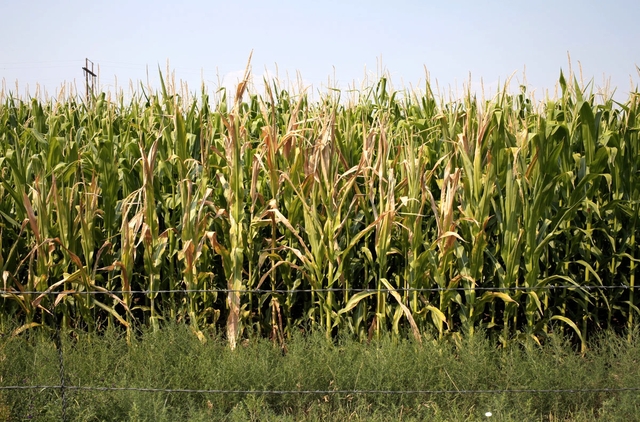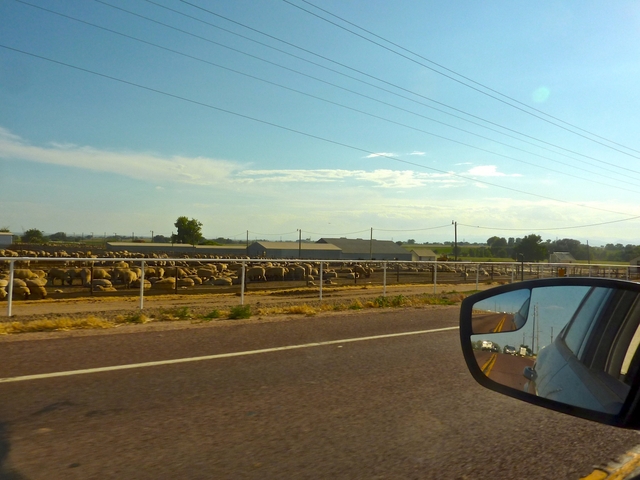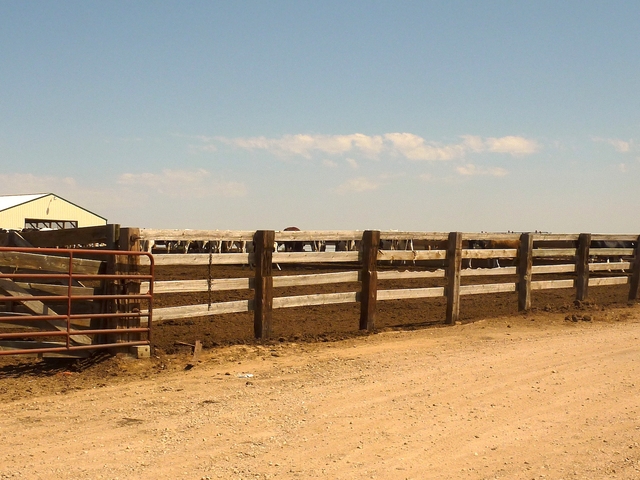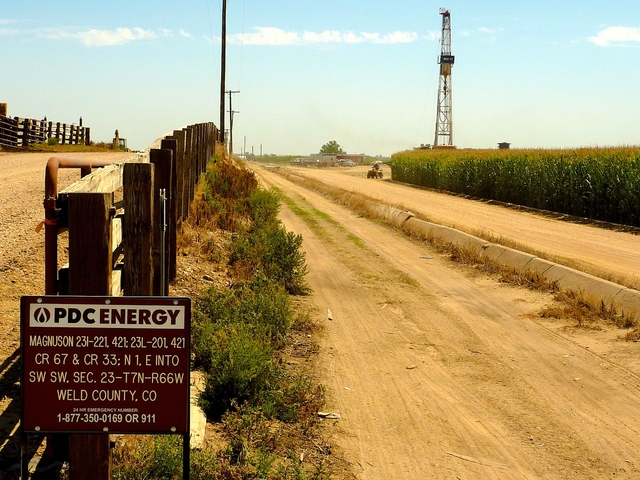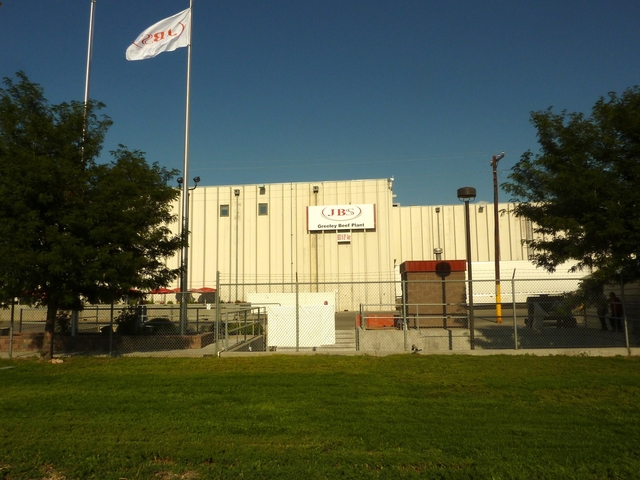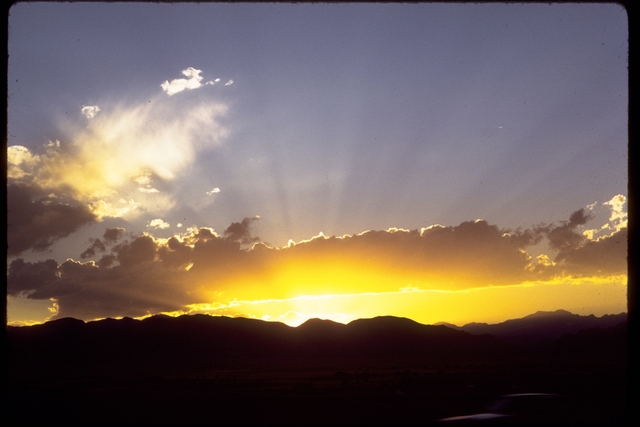Cropped Out: Environmental History Through a Car Window
I don’t love to drive, but last year I committed myself to a lifestyle that revolves around it. I took a job teaching history in Greeley, Colorado, and decided to live in Fort Collins, about forty minutes away. Colorado drivers turn pushy on the freeway and the interstate offers little more than antiseptic views of big box stores: the Centerra Outlet Mall in Loveland is the main beacon you pass on the way to my university.
Nothing in this new landscape connected me to my work. I study urban Africa, and I write about the history of waste. Trash is an amazing topic for a lazy scholar; it is chock full of metaphorical potential. Encountering waste is a sensory experience that embodies multitudes of biological and cultural taboos, and thus holds a powerful ability to tell stories. But its power has always struck me as far more evident in the tight, thrifty geographies of cities, where the limits of space force confrontations with our own trash. Even when I am not looking at waste, my work still seeks out what gets scuttled to the margins. This new landscape feels too open and flat for that. To my unfocused eyes, it seems eerily free of secrets: a margin-less blur for miles in each direction beyond the frame of my car windows.
The road this morning has patches of ice. My car tells me it is 16 degrees out. The sky is still mercifully blue. Most of the fields are cut short, laid bare and dotted with snow. The giant wheeled industrial irrigation sprinklers look like delicate dinosaur fossils hovering above the brown and white. It’s November now; I’ve settled into the job and joined a carpool with two of my new colleagues. Looking around, I realize that our route, taking a wide berth around the interstate, is a literal backwater of environmental history. In particular, the smells that overcome us on the road and the cloud of smoke that hangs above Greeley’s skyline force me to reconsider the scenery. Our commute is an olfactory rite of passage every morning and evening and so I decide to inventory its odors. It’s time to peer closer at the flatness.
Driving to Work
Each morning I leave my house going east on Mulberry Street, filtering through a few lights and then onto a two-lane country road. Twenty minutes later, one right turn on an unassumingly numbered road, then a left turn ten minutes after that, followed by a quick right onto the Pan-American Highway, and I am on the outskirts of Greeley. The drive is the clearest articulation of my new reality. Having left a big city behind, I have exchanged my exasperation over traffic for the maddening crawl of industrial tractors.
Once we’re about ten miles out of Fort Collins, the first smell to hit my nose is the North Weld County Dump run by Waste Management, though the scent rarely seems to gather much strength this time of year. There’s a short line of blinking garbage trucks in the left lane as I pass by, but it is hard to see much from the road besides a long row of tall netting. The type you see around baseball diamonds. A collection of white birds hovers above the trash heaps.
Craning my neck to look in, I remember touring a municipal waste dump in Lagos, Nigeria. Lent tall pairs of gumboots, we set out across the dump, me in utter disbelief of where I was and what I was doing. The sanitation trucks would tilt their loads off the back end as men with iron hooks in their right hands and bags in their left rescued anything of miniscule value. Meanwhile, white herons would stalk through piles of trash trailing soggy plastic bags pinned by their elegant legs. I imagine the Waste Management Dump has no village living within it, no women selling food and men bundling up copper wire after burning off the plastic coating. Our dump is invisible. Yet one particularly windy afternoon when I passed by, a collage of colorful trash had formed against the netting.
A bit farther down the road from the dump is the sheep farm. If you have ever smelled the deep odor that results from thousands of pounds of sheep shit, then you simply know. You know that it’s not just the smell of shit. It’s mud and wet fur, dirty snow, and shit all combined. And when I say deep, I mean it has an alarmingly deep earthiness that seems to hit the back of your brain, but I also mean “deep” in that it can stop you short in some very philosophical way. The smell is so offensive yet fundamentally connected to the food we eat. I get a strange, punishing pleasure from struggling each morning with reconciling those facts. When passing the sheep we give them names, imagining what they say to each other. “Ah, fuck” usually suffices, particularly when they are covered in a thick layer of snow.
Getting that sheep smell out of the car vents takes a while. Next, I turn right on to County Road 33. Even now there remain some fields along CR33 full of stiff brown stalks of corn, their diminutive-looking ears slumped over backwards in raspy husks. We puzzle for a while about why some haven’t been harvested, whether they were forgotten or spoiled. My deficient farmland literacy becomes clear as I try to figure out which fields are used for what. I grew up surrounded by agricultural land in Oregon, but this is new terrain. To an outsider, it is American monocrop tedium. An invitation to tune out: there are entire genres of music borne of its visual minimalism.
I am not the first new resident to find it boring. In 1871, as Grace Greenwood was traveling westward, her fellow travelers warned her against making a go of it in Greeley.
You’ll die of dulness [sic] in less than five hours. There is nothing there but irrigation. Your host will invite you out to see him irrigate his potato-patch; your hostess will excuse herself to go and irrigate her pinks and dahlias. Every young one has a ditch of his own to manage.
Those potatoes and dahlias are now mostly corn, soybean and sugar beets, which seem even duller to my eyes. But Americans are finally starting to push back against our nutritional tedium that mimics these fields: corn, corn, soybeans, corn.
Along this road, each week we see the construction of another fracking installation. The strange huddles of machinery and trucks look like an invading army beginning a winter campaign. They have arrived quickly and in huge numbers. In fact, our university president informed us recently in an email that the mineral rights underneath our campus had been leased for the next five years to a company she described without irony as a “boutique operator” of “horizontal drilling technology.” I don’t know that I’ve ever found myself in the midst of a boom environment before, and it is unsettling how quiet and odorless it all becomes from behind the car window.
Turning off of CR33 we are close to Greeley but there is still the olfactory pièce de résistance. The site that orchestrates much of the economy and fate of this landscape also proves my naiveté in assuming there are no centers and margins in this environmental tedium. The JBS Beef Plant is the center and the margins. The beef plant is the heart of Greeley, if not geographically then in all other ways.
Before I knew anything about Greeley, I knew about its smell. And it certainly played a part in my decision to live in Fort Collins. It is a smell that has seasons and routines and days of the week. It has a life of its own while also being an indicator of the life of the city. And for those who live in the Front Range’s less odorous cities, it has also become the easiest way to dismiss Greeley in the least amount of words: “Oh, it smells there.” On my first day of class, the students explained that the smell’s peaks and valleys correspond to the shifting days of the week when they burn the cattle carcasses. Even if this is more legend than fact, I find myself walking around thinking, I am smelling burning cattle carcasses right now.
The beef plant has been part of Greeley for a long time, and its biography tells a very American story. The story ends with beef but it starts with sugar beets. It is a story about refugees, cultural marginalia, and putting down roots in far away places. The first wave of refugees to make a go of it in Greeley were German Russians who fled from Alexander II and famine after about 100 years of freedom and prosperity along the Volga river. They poured into North and South America and in particular Kansas, Colorado, Iowa, and Nebraska, where they found work in the burgeoning beet industry. By the mid-eighteenth century in Europe, the beet was discovered as a proficient and cheap stand-in for sugar cane. Sugar beet production in the late nineteenth and twentieth century has risen and fallen with the vagaries of global sugar cane politics, particularly vulnerable to the United States’ tumultuous relationship with Cuba. Yet it has generally been ascendant and northern Colorado, with proper irrigation for the water-intensive crop, became a prime environment for its cultivation. Thus it was these first refugees, familiar with similar types of farming, who established the industry’s foothold in Colorado.
You can still see the mark of this first generation of immigrants between the railroad tracks and the sugar beet factory, east of town. But many of the institutions that were hallmarks of ‘little Russia’ have since become palimpsests of migrant labor history. The churches now carry new signs, new paint jobs, and new Spanish-speaking worshippers. The neighborhoods are now a mixture of several unique generations of immigrant labor still literally across the tracks from town. Mexican nationals began arriving in the early twentieth century to work the fields, uninvited to become citizens. The New Deal provided a colonia for them on the outskirts of town, a cluster of small dark adobe buildings so they could live in close proximity to the fields (and, one would assume, away from the city). The neighborhood still exists, yet only two of the original adobe houses remain standing. The baseball diamond is overgrown.
What connects this history of beet farming to the beef plant is the Monfort family. The modest Monfort farmhouse still stands roughly across the Pan-American Highway from the meatpacking plant. I passed it unknowingly dozens of times before someone pointed out that it was the cradle of the Greeley beef empire. The Monforts moved to Greeley from Illinois in the early twentieth century and transformed their small farm into one of the world’s largest beef producers by first shifting their practice of grazing cattle to feeding them in feedlots, particularly after noticing that feeding them sugar beets made the beef taste better. By the 1950s the Monforts realized they could save massive amounts of money for themselves and neighboring farms by slaughtering cows rather than loading them on trains destined for larger Midwestern markets. Sugar beets and corn were rerouted to the stockyards, which for many years simply drained smelly effluent into the Poudre River that ran temptingly close to their fences. And with the stockyards came a slaughterhouse.
The 1960s were the heyday of the Monfort beef plant. Eric Schlosser calls this period one of “compassionate paternalism,” led by Kenneth Monfort himself. The beef plant provided some of the best-paying jobs in Greeley. Employees were unionized and received bonuses for late shift work and rewarded based on seniority. Monfort was a liberal democrat, an “outspoken opponent of the Vietnam war” and “one of the two people from Colorado to earn a place on President Nixon’s ‘enemies list.’” But then he changed, as did the meatpacking industry.
A new, cheaper method of meatpacking slowly infiltrated the Midwestern states in the 1970s. The ‘disassembly’ line de-skilled labor and had an atavistic effect on the health and safety standards of the meatpacking business. A massive workers’ strike in 1979 ended poorly for the workers, who returned after eight weeks with no contracts. Worker unrest continued and the plant closed, reopening again in 1982 without a union. Adjusted for inflation, these workers were earning one third less than what their counterparts had when the plant first opened. It should not be surprising that the population that came to reshape Greeley was migrant labor from south of the border, less able to demand workers’ rights and higher wages.
Driving past the plant and into the outskirts of town, the effect of this shift is palpable. Eighth Avenue is a strip of 1960s hotels that look both perennially open and forever closed. Scattered in between is a mish mash of dollar stores, thrift stores, and car repair shops housed in the shells of Greeley’s old brick buildings. While the avenue is not the sole geography of Greeley, it indelibly marks your entrance to town from the north. This is the landscape of the low-paid hourly employee.
Currently owned by JBS, a Brazilian corporation that produces more beef and pork than any company in the world, the company is also part of Swift and ConAgra. I frankly can’t keep straight which company is nested within which. In 2006 US immigration officials raided the major meat packing plants of Swift and Company scattered throughout the Midwest and over 1,200 illegal immigrants were carted away, leaving a spate of empty chairs all across Greeley schools.
The raids left the company reluctant to hire Latino workers. So they sought out a different demographic precisely when a strange new one presented itself. Arriving in Emporia, Dodge City, Sioux City, and Greeley, to name a few places, Somali, Eritrean, and Ethiopian refugees trickled in to take up these meat-packing jobs. Word had spread fast among the refugee community because the job required no previous experience.
And here I am led back to Africa. If you look closely on Eighth Avenue on the way to campus, we pass the East African Market, a Halal market with posters in the window advertising cheap international phone cards. I imagine Somalis coming here to the plant, reworking their own fundamental relationship with cattle as a result. Cattle, as is the case in many parts of Africa, are the main currency and source of security for rural Somalis, particularly in the past decades battered by war and famine. For Somalis, cattle offer not only milk and meat, but also grain and other essential commodities. They hold immense economic and cultural value.
After years of staggering hardship and displacement, these refugees come to a factory where cattle abound. Yet these are disembodied carcasses rather than living beasts. It reminds me of a New York Times article about the Somali drought in 2011 that ended with a man named Abdi Farah Hassan commenting wistfully, “I never thought I’d lose all my cattle…I never thought I’d be a refugee.” I don’t think it would be presumptuous to imagine that those two events for him seemed to be one in the same: losing his cattle was the same as losing his place on earth. Perhaps he is here now, a refugee in a new land of cattle.
But this current chapter isn’t just a story of helpless refugees quietly taking up whatever job and wages that other Americans no longer want to take. They have brought their culture quietly onto the streets and into classrooms, bringing Ramadan and daily prayer onto the floor of the meatpacking plants to the frustration of many, and striking to get prayer breaks when they were revoked.
Greeley seems to represent an antiquated regionalism, yet its labor history also connects it to an immense swath of the globe. This sense is only amplified by reaching even further back to the town’s foundation as a utopian society started by Nathan Meeker, the agricultural editor for Horace Greeley’s New York Tribune. Meeker wanted to create a town based on “faith, family, education, irrigation, temperance, agriculture, and home.” He recruited for this enterprise with a passionate letter published in the Tribune and received over 3,000 responses. People moved to Greeley to get away from somewhere else, to either reclaim an old way of life or seek ways to use their skills in an environment somehow akin to the steppes of Russia, the fields of Mexico, or the cattle culture of Somalia.
Everything on my commute began to fit together. Yet as a migrant in my own right, I could not draw any conclusions. Was this an example of American thrift and reuse? Or less romantically, just a forgotten place where those on the margins propped up the middle of America? The sugar beet and the cattle and sheep industries flow into one another, like the Ouroboros eating its own tail. Even now when sugar beets are no longer regularly fed to cattle, their crown foliage is mixed with corn fodder and ensiled to make feed while leftover beet pulp is collected for fattening cattle. The old beet factory east of the railroad tracks has now been retrofitted into a factory for the world’s largest maker of mozzarella cheese. Meanwhile farmers are nervously eyeing the army of gas men arriving in town, wondering whether the water they have long had protected access to will in the future become food or oil.
Reuse, overuse, and exploitation have become blurred.
Driving Home
I can’t detail my commute through this agricultural pastiche and neglect to describe the turn westward that marks my way home. At this time of year, it happens at just the right time, when the sky is turning the color of melted butter and pink marshmallow Peeps. Turning west means turning to the mountains. As they telescope into my field of vision, all the rest recedes from the frame. Heading towards the mountains from Greeley feels like a salve. The smell recedes, the glimpse of topography excites.
But if we think the mountains are removed from the frame, it is only by willfully turning our heads too far in one direction. We can’t so easily separate their histories. Around the same time that sugar beets and Russian Germans were pushing roots down into the soils of the plains, Woodrow Wilson established Rocky Mountain National Park, drawing a boundary between the agricultural feats of man and the sublime feats of nature.
Yet somewhere, tucked into the Rocky Mountains west of Fort Collins is the Never Summer Mountain Range, where you’ll find the Grand Ditch. Decades before Wilson drew lines in the mountains, Japanese migrant workers in the 1890s camped out at 10,000 feet and carved out by hand a 14.3 mile ditch in the mountain range. The Grand Ditch diverts water down to the Front Range towns allowing for an ‘irrigated Eden’ in a place where I haven’t seen rain in close to two months.
Rebecca Solnit writes about the challenge of reconciling environmental history and human history within the same narrative. She compares the task to those mind-bending images where the wine glass turns into a profile of kissing lovers when you look at it askance: even when you know they are both there, it can still be hard to see them simultaneously. This is also true within environmental history in regards to the beautiful and the ugly. It seems impossible often to find them simultaneously. The discipline has room for both but we seem incapable of capturing them in the same frame unless it’s a narrative of declension: something beautiful that we have exploited to the point of ugliness.
To be dulled by the monotony of the endless fields on my commute was to stop looking for the margins. And equally, to see relief in the mountains when they came into view was to disconnect from the rest. I feel as if my commute passes daily over some sort of threshold of American history and environmentalism. A community in so many ways defined by reinvention butting up against land prized for its preservation in perpetuity. Perhaps a noble pairing. Perhaps a striking inequality.
People love visiting Colorado. Nobody visits Greeley. I live here now, winding my way between the mountains and the plains.


